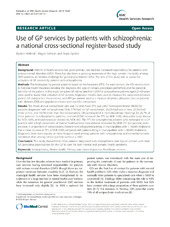| dc.rights.license | Copyright Hetlevik et al.; licensee BioMed Central. 2015 | |
| dc.contributor.author | Hetlevik, Øystein | en_US |
| dc.contributor.author | Solheim, Magne | en_US |
| dc.contributor.author | Gjesdal, Sturla | en_US |
| dc.date.accessioned | 2015-12-11T11:13:25Z | |
| dc.date.available | 2015-12-11T11:13:25Z | |
| dc.date.issued | 2015-02-18 | |
| dc.Published | BMC Health Services Research 2015, 15:66 | eng |
| dc.identifier.issn | 1472-6963 | |
| dc.identifier.uri | https://hdl.handle.net/1956/10746 | |
| dc.description.abstract | Background Reform of health services has given primary care facilities increased responsibility for patients with serious mental disorders (SMD). There has also been a growing awareness of the high somatic morbidity among SMD patients, an obvious challenge for general practitioners (GPs). The aim of this study was to assess the utilisation of GP services by patients with schizophrenia. Methods The Norwegian list patient system is based on fee-for-service (FFS). For each contact, the GPs send a claim to National Health Insurance detailing the diagnosis, the type of contact, procedures performed, and the personal identifier of the patient. In this study complete GP claims data from 2009 for schizophrenia patients aged 25–60 years were used to assess their utilisation of GP services. Regression models were used to measure the association between patient, GP and practice characteristics, with FFS per patient used as a measure of service utilisation. Data on patients with diabetes (DM) and population means were used for comparison. Results The mean annual consultation rate was 5.0 and mean FFS was 2,807 Norwegian Kroner (NOK) for patients diagnosed with schizophrenia. Only 17% had no GP consultation, 26.2% had one or two, 25.3% had three to five, and 16.1% more than five consultations. GPs participated in multidisciplinary meetings for 25.7% of these patients. In schizophrenia patients, co-morbid DM increased the FFS by NOK 1400, obstructive lung disease by NOK 1699, and cardiovascular disease by NOK 863. The FFS for schizophrenia patients who belonged to a GP practice with a high proportion of mental health-related consultations increased by NOK 115 per percent point increase in proportion of consultations. Patients with schizophrenia living in municipalities with < 10,000 inhabitants had a mean increase in FFS of NOK 1048 compared with patients living in municipalities with > 50,000 inhabitants. Diagnostic tests were equally or more frequent used among patients with schizophrenia and comorbid somatic conditions than among similar patients without a SMD. Conclusion This study showed that most patients diagnosed with schizophrenia had regular contact with their GP, providing opportunities for the GP to care for both mental and somatic health problems. | en_US |
| dc.language.iso | eng | eng |
| dc.publisher | BioMed Central | eng |
| dc.rights | Attribution CC BY | eng |
| dc.rights.uri | http://creativecommons.org/licenses/by/4.0 | eng |
| dc.subject | Schizophrenia | eng |
| dc.subject | Mental health | eng |
| dc.subject | Primary care | eng |
| dc.title | Use of GP services by patients with schizophrenia:A national cross-sectional register-based study a national cross-sectional register-based study | en_US |
| dc.type | Peer reviewed | |
| dc.type | Journal article | |
| dc.date.updated | 2015-11-05T13:13:56Z | |
| dc.description.version | publishedVersion | en_US |
| dc.identifier.doi | https://doi.org/10.1186/s12913-015-0719-1 | |
| dc.identifier.cristin | 1255610 | |
| dc.subject.nsi | VDP::Medisinske fag: 700::Helsefag: 800::Epidemiologi medisinsk og odontologisk statistikk: 803 | |
| dc.subject.nsi | VDP::Midical sciences: 700::Health sciences: 800::Epidemiology, medical and dental statistics: 803 | |
| dc.subject.nsi | VDP::Medisinske Fag: 700 | en_US |

